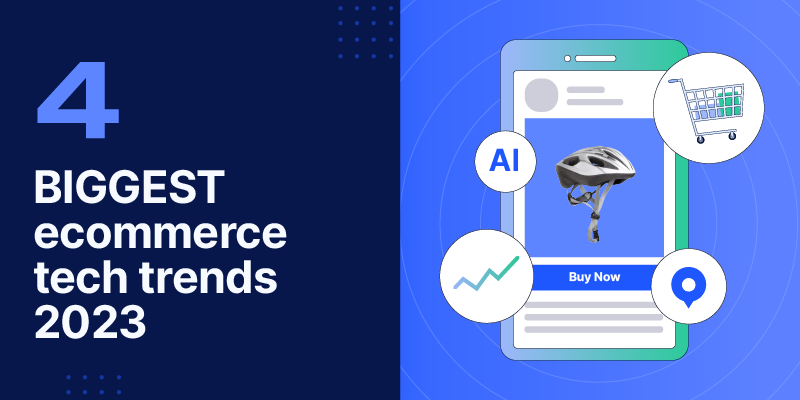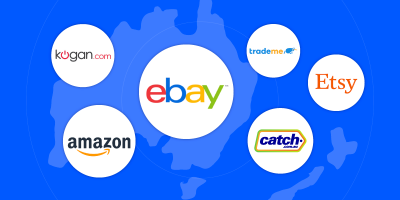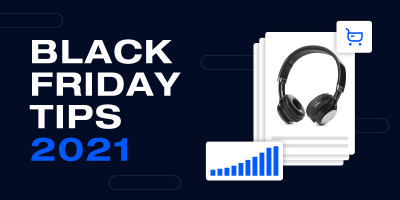The ecommerce industry sits snugly at the intersection of computer science and business, which means change happens at double time. Developments in technology are impacting every aspect of the selling process, from product data to product delivery.
To help you imagine what the future of online selling looks like, we identified four blossoming trends in ecommerce technology and asked industry experts to weigh in on what businesses can do to adjust to the new landscape.
1. Artificial Intelligence is changing market accessibility and economies of scale
Generative AI is changing the industry
We can’t talk about important tech trends without starting with the technology that captivated the world in 2023: generative AI.
You’ve likely heard of ChatGPT by now, have come across AI art, and have maybe even heard an AI voice-over in a video. These are all examples of generative AI, a subset of artificial intelligence that is transforming content creation. It leverages machine learning algorithms to understand context, learn patterns, and generate content that can mimic a human’s style.
That last bit is important because people don’t buy from dogs, cats, or boa constrictors—they buy from other humans. The closer generative AI can mimic the way a human might respond to a customer query, create an aesthetically pleasing chart to explain a difficult concept, or even yell out recipe directions in the blunt, yet charming style of Gordon Ramsay, the more use cases it can create for all businesses, ecommerce operations included.
In July 2023, the CEO of Dukaan, an Indian ecommerce startup, replaced 90% of his support staff with a chatbot powered by AI. The CEO reported that the average time taken to resolve a customer’s issue dropped by almost 98% when interacting with the chatbot. While the long-term efficacy of this move is yet to be seen, it’s an example of how generative AI tools are being adopted into regular ecommerce operations today.
The chatbot has been around for a while, but using AI trained on custom business data like sales sheets, marketing material, and even technical documentation dramatically changes the business use cases of what was once a much simpler pop-up chat feature.
According to Capterra’s February 2023 “Retail Chatbots Survey,” 67% of ChatGPT users said they “often” or “always” felt understood by the bot, compared to 25% of retail chatbot users.
Some ecommerce businesses are beginning to use generative AI to automate content creation, including product descriptions, personalized emails, and even visual content like lifestyle images. Businesses can play to generative AI’s strengths by using it as an assistant of sorts, to create quick drafts, mock-up assets, and generate ideas.
Google, Meta, and Microsoft all have a seat at the AI-for-ecommerce table
In May 2023, Google announced that it was “introducing a new era of AI-powered ads.”
“For many years, it has been quietly helping in the background, supporting advertisers in maximizing their time and return on investment,” Google wrote in the announcement.
Most advertisers are already familiar with Performance Max’s AI capabilities for creating optimized ads. However, Google has developed other notable AI tools for ecommerce brands to take advantage of.
This year, the tech giant introduced a natural-language conversational experience on the merchant side of Google Ads. It’s designed to “jumpstart campaign creation and simplify Search ads by combining your expertise with Google AI.”
By feeding the AI a landing page from your website, it is able to summarize it and generate relevant keywords, headlines, descriptions, images, and other assets for your ad campaigns.
Google announced that it would use generative AI to create and adapt Search ads based on the context of a consumer’s search query.
On a similar note, Meta and Microsoft have also announced their own generative AI features for advertisers in 2023.
There’s more than just one type of AI changing ecommerce
While much of the buzz today is around generative AI, there are other AI tools improving the selling experience.
For example, Feedonomics uses FeedAi to automatically categorize products faster and more accurately than manual categorization. Our AI works for any channel that accepts a Google Product Category, including Google Shopping, Meta, Instagram, Microsoft Shopping, Pinterest, and Snapchat, and it has been rigorously tested on clients who sell across 80 unique categories.
Using FeedAi in conjunction with the developing advertising features of these major platforms creates huge opportunities for businesses to increase their reach, while also saving valuable resources.
Demo FeedAi today
2. Social commerce has further bridged the gap between content and sales
Social commerce—the buying and selling of items or services through social media platforms—is the new status quo, with major platforms like TikTok, Pinterest, and Instagram investing heavily in ways to simplify the transition from content consumption to purchasing.
These platforms also support short-form video content and live streams, two major changes in online communication that shorten the space and time between businesses and their customers.
“I would definitely recommend having a presence on multiple social commerce channels, as it gives you the opportunity to reach a broader audience and connect with your customers in a variety of ways. With that being said, each channel needs its own unique strategy. In order to communicate with your customers effectively and create a personalized shopping experience, your visual content and messaging needs to be adapted to fit the distinct features, user demographics, and user behavior of each platform.”
Personalization is like never before
All major social media platforms use algorithms to curate personalized content for consumers based on demographics, likes, dislikes, browsing history, where they live, login activity, and more. To take advantage of this personalization and stand out from the competition, brands need to put extra effort into understanding their customer profiles and learn how to best communicate with them.
Checking out is easier than ever from your digital storefronts
The development of native checkout—the ability to make in-app purchases—spearheaded the rise of social commerce. TikTok, Snapchat, Pinterest, Instagram, and Facebook all have native checkout features.
Brands can now have digital storefronts everywhere they communicate with their customers. But just opening a storefront on these channels isn’t enough, because the way customers prefer to consume content is also changing quickly.
Content preferences are constantly evolving
Consider these statistics from The Leap:
- 73% of consumers prefer to watch a short-form video to learn about a product or service
- 59% of short-form videos are watched for 41% to 80% of their length
- 21% of marketers plan to tap into short-form videos for the first time in 2023
According to Statista, there are an estimated 161.4 million live stream viewers in the U.S. in 2023. Internationally it has proven more successful, with 750 million live stream consumers in just China alone (that’s 70% of the total internet users in China).
LinkedIn, Instagram, YouTube, Facebook, Snapchat, and TikTok all have live features that allow creators to receive immediate feedback from their audiences and communicate with them in real time.
3. Developments in product data optimization, syndication, and synchronization have simplified omnichannel commerce
Omnichannel commerce became a viable strategy once organizations found efficient ways to share data across critical systems and platforms.
These connections are vital because more than half of B2C customers engage with three to five channels each time they make a purchase or resolve a request, according to research from McKinsey.
Data feed management platforms are one of the tech advancements driving the omni wave because they bridge the gap between wherever a business houses its product data, the shopping channels it wants to sell on, and other downstream systems.
These platforms also allow merchants to use that single source of data to create unique catalog exports for every channel and automatically update product listings when data is refreshed. This makes scaling the business and adding new channels a simpler proposition because it doesn’t require in-house developers to build an additional integration each time.
“Using a feed management platform has allowed us to be extremely flexible in the way we present products across sales channels. With clients that have tight deadlines and quick-moving inventory, it’s important to be agile when it comes to updating product titles, managing in-stock versus out-of-stock product, and increasing the visibility across all channels. It’s critical to make sure products are cohesive and consistent across all sales channels, especially as we evolve with omnichannel marketing strategies. Having that one connection point allows us to manage the feed in a more streamlined manner than building point-to-point integrations.”
Product data optimization is making listings more competitive
Today’s marketplaces and ad channels are more competitive than ever, so meeting the bare minimum listing requirements with your product data isn’t enough to make you stand out. Optimized catalogs improve the search relevancy of product listings, allowing them to reach customers who are more likely to purchase.
Product listing optimization can now be automated with feed management platforms, saving time on the following processes:
- Creating consistent product listings across all channels with clean titles, descriptions, bullet points, and more
- Inserting valuable keywords and product nouns into your titles
- Categorizing products accurately for each sales channel
- Grouping product variants together
- Filling in as many category-specific or channel-specific recommended attributes as possible
Data governance features are playing a crucial role in safeguarding omnichannel operations
With so much data being exported to multiple channels, businesses with large or constantly changing catalogs need a way to keep their product data accurate and their accounts in good standing.
Robust feed management platforms come with data governance features that can catch problem-causing inconsistencies in data.
These safeguards protect businesses triggering a variety of responses to data changes within the platform:
- Alerts that warn of potential issues or missing values
- Hard stops that prevent bad data from being published
- Automated retries for imports or exports that timeout while processing
- Inventory buffers that prevent overselling
- Random sampling to check data quality within large catalogs
- Data tracking to spot discrepancies
- Export conditions for outbound data
Using a combination of these safeguards, businesses can now create safety nets to catch errors before they compound and slow down operations and reduce, or potentially eradicate, valuable revenue streams.
4. Fulfillment processes have significantly changed for consumers and corporations since 2020
Pick-up options grow in popularity along location-based advertising tech
In 2020, the pandemic made buy online, pick up in store (BOPIS) and curbside pickup necessary options for businesses to serve their customers while following social-distancing regulations. Fast forward to 2023 and these fulfillment services remain popular.
According to a PYMNTs study, nearly one-third of U.S. ecommerce shoppers picked up their most recent online purchase using one of these two fulfillment methods.

These developments benefited omnichannel-focused retailers who were better equipped to use location-based advertising options like local inventory ads (LIAs) to further drive customers to their physical stores. By integrating LIAs into their omnichannel strategy with robust modern technology like a feed management platform, they were able to let shoppers know they offered BOPIS and curbside pickup and synchronize their store stock with their online channels.
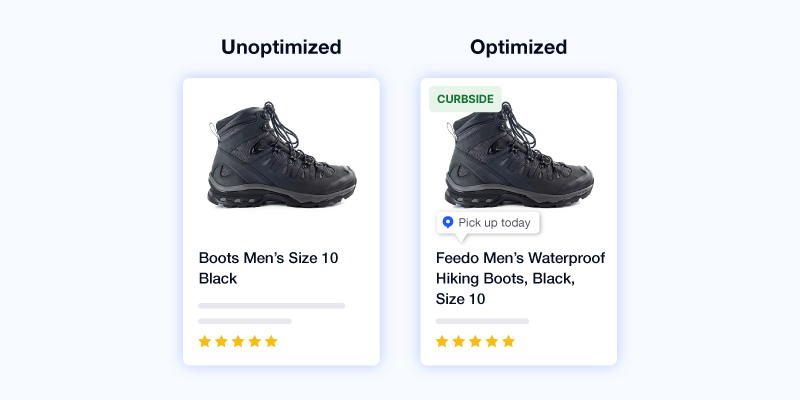
Both consumers and omnichannel-enabled businesses benefit from these changes. For businesses, they are able to drive more customers to their physical locations and promote fulfillment methods that decrease the costs associated with last-mile delivery. Customers get more fulfillment options and the ability to pick something up the same day without having to step out of the vehicle.
Trending toward consolidation in multichannel order management
In December 2022, Amazon announced that its Multi-Channel Fulfillment (MCF) service would start delivering packages without Amazon branding on them.
Amazon MCF is a third-party logistics (3PL) service for ecommerce fulfillment that merchants, regardless of whether they sell on Amazon or not, can use to fulfill orders on any off-Amazon sales channel, including their own website. This update allowed merchants to fulfill orders from marketplaces that have rules about how products are packaged upon delivery.
According to Amazon, more than 450,000 Amazon sellers have used MCF to handle the fulfillment of their off-Amazon orders. This is significant because merchants now have access to a global fulfillment network known for quick turnaround times and dependable delivery rates.
MCF integrates with powerful software solutions like Feedonomics to enhance the benefits of an already robust fulfillment service:
- Streamline and automate fulfillment – Viewing orders from all marketplaces in a single dashboard, and setting pricing or inventory rules on a per-channel basis.
- Route orders based on defined criteria – Setting rules and formulas to route orders based on SKU, brand name, product category, product availability, and more.
- Offer a first-class customer experience and optimize inventory – Avoiding order cancellations and stockouts with inventory buffers that reserve stock for low-inventory or best-selling products and allocating inventory across channels.
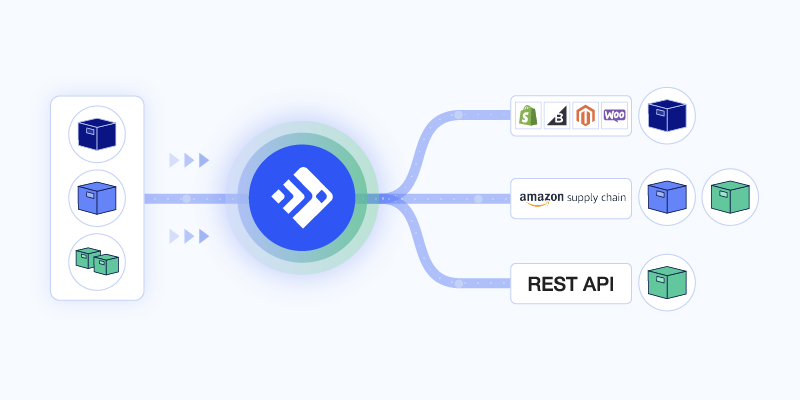
Omnichannel-minded businesses are pairing advanced order management tech with the modern logistics networks of companies like Amazon to consolidate their fulfillment operations on two fronts.
Order information coming in from disparate channels is passed to the OMS, allowing businesses to take action on orders from a single dashboard. This gives businesses a scalable approach to their order fulfillment and allows them to view the order lifecycle across all channels.
Learn how FeedAMP unlocks your marketplace growth

With its leading data feed management platform, Feedonomics helps brands, retailers, and agencies optimize and list products on hundreds of shopping destinations around the world. Learn more about our full-service solutions for advertising channels and marketplaces.

